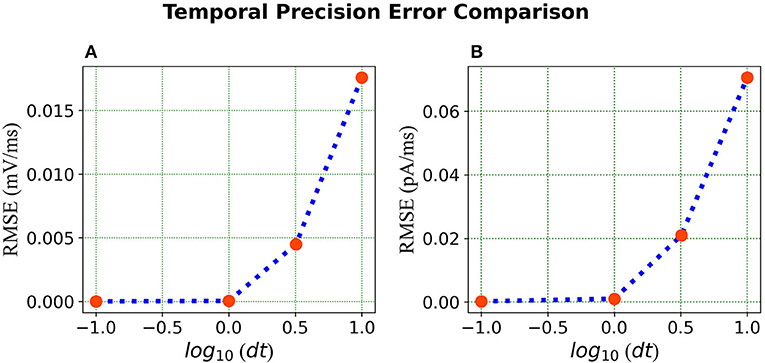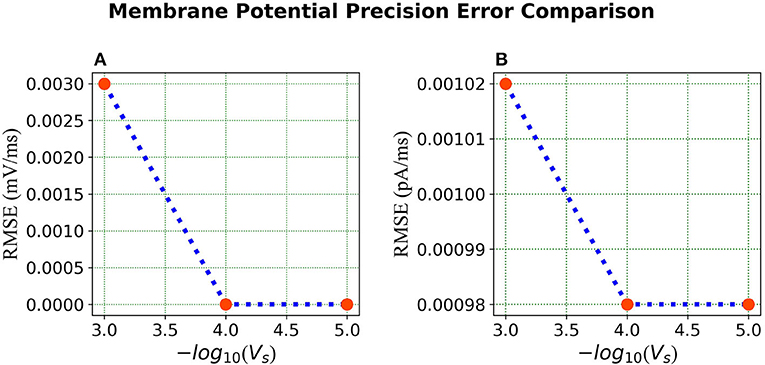A corrigendum on
Mapping and validating a point neuron model on intel's neuromorphic hardware Loihi
by Dey, S., and Dimitrov, A. (2022). Front. Neurosci. 16:883360. doi: 10.3389/fnins.2022.883360
In the published article, there was an error in Figure 7 and Figure 9 as published. The units for the Root Mean Square Error (RMSE) in both figures were in mV and pA (per run, about 500ms), but should have been in mV/ms and pA/ms as per aforementioned results. The revised figures with the corrected units as mV/ms and pA/ms appear below.

Figure 7. Error comparison for different temporal precisions—(A) Membrane potential error. (B) Current error. In both panels, the RMSE for the corresponding state is plotted against the log of the temporal precision dt.

Figure 9. Error comparison for different membrane potential precisions—(A) Membrane potential error. (B) Current error. In both panels, the RMSE for the corresponding state is plotted against the –log of the voltage scale Vs.
In the published article, there was also an error in Results, Simulation of Different Neuron Classes, Paragraph 4. The range of the bias mantissa is incorrectly stated as [2−12, 212] when it should be [-212, 212]. A correction has been made to the paragraph below:
“We reiterate here that Loihi imposes certain bit constraints on the parameters. For instance, membrane potential threshold ranges from 0 to ± 223, membrane time constant allows 0 to 212 bits. The membrane capacitance is integrated with bias current (Equation 18) with bias mantissa allowed a range between [−212, 212] and bias exponent a range between [0, 7]. Thus, a good range of parameters can be mapped well into Loihi and a limit to the “exactness” can be attributed to the low-fixed-precision nature of Loihi as most state and configuration variables are in the range of 8–24 bits”.
The authors apologize for these errors and state that this does not change the scientific conclusions of the article in any way. The original article has been updated.
Publisher's note
All claims expressed in this article are solely those of the authors and do not necessarily represent those of their affiliated organizations, or those of the publisher, the editors and the reviewers. Any product that may be evaluated in this article, or claim that may be made by its manufacturer, is not guaranteed or endorsed by the publisher.
Keywords: neuromorphic computing, LIF models, neural simulations, validation, performance analysis
Citation: Dey S and Dimitrov A (2022) Corrigendum: Mapping and validating a point neuron model on intel's neuromorphic hardware Loihi. Front. Neuroinform. 16:1023486. doi: 10.3389/fninf.2022.1023486
Received: 19 August 2022; Accepted: 26 August 2022;
Published: 14 September 2022.
Edited and reviewed by: James B. Aimone, Sandia National Laboratories (DOE), United States
Copyright © 2022 Dey and Dimitrov. This is an open-access article distributed under the terms of the Creative Commons Attribution License (CC BY). The use, distribution or reproduction in other forums is permitted, provided the original author(s) and the copyright owner(s) are credited and that the original publication in this journal is cited, in accordance with accepted academic practice. No use, distribution or reproduction is permitted which does not comply with these terms.
*Correspondence: Srijanie Dey, c3JpamFuaWUuZGV5QHdzdS5lZHU=; Alexander Dimitrov, YWxleC5kaW1pdHJvdkB3c3UuZWR1
 Srijanie Dey
Srijanie Dey Alexander Dimitrov
Alexander Dimitrov